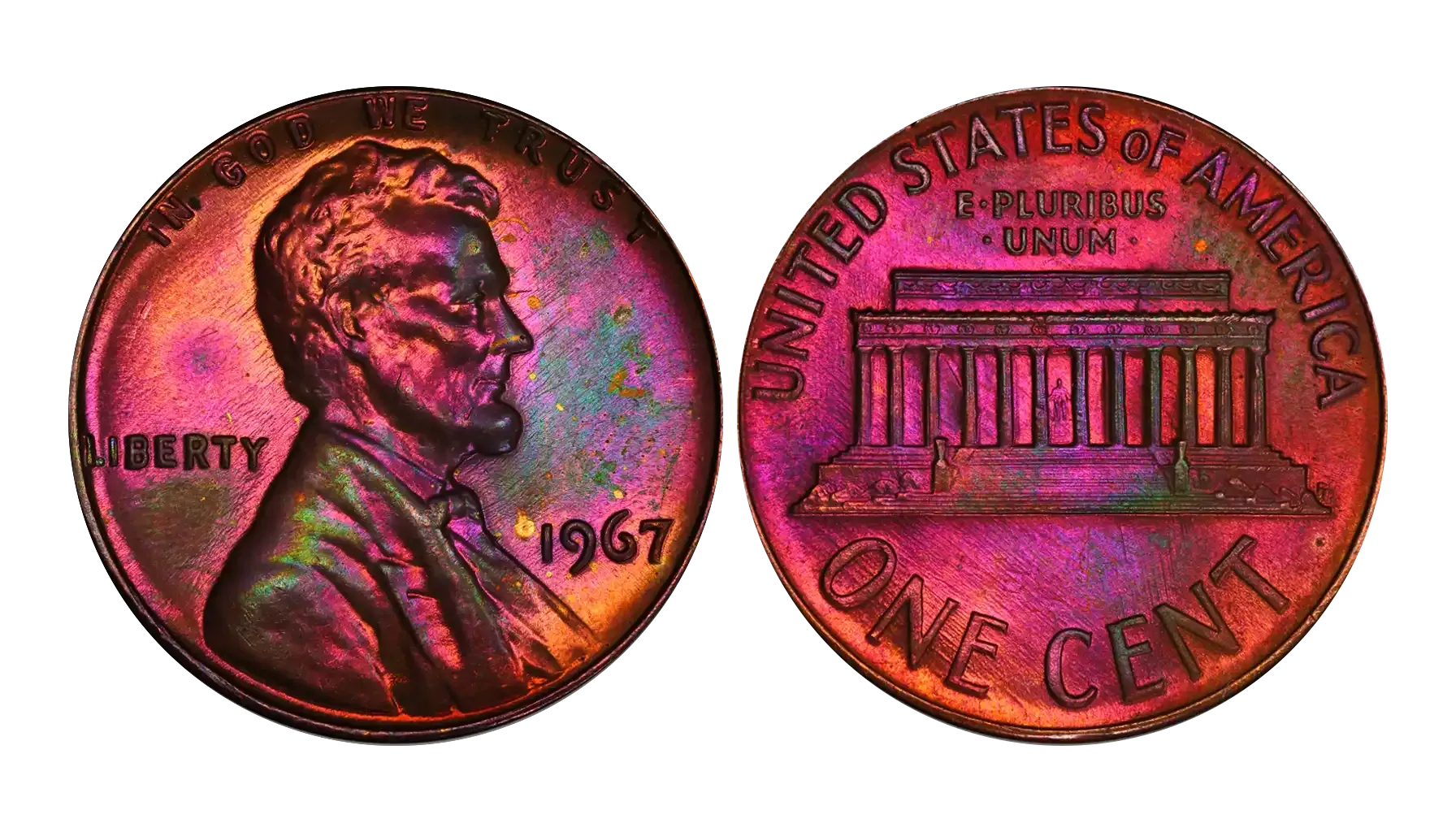Contents:
- Unearthing the Legacy of the 1965 Kennedy Half Dollar Value
- How Much Is a 1965 Half Dollar Worth Today?
- What Makes a 1965 Kennedy Half Dollar Rare?
- The Switch to 40% Silver – Why It Matters
- Understanding SMS Coins and Their Higher Value
- Common Varieties: 1965 Kennedy Half Dollar Error
- How to Tell if Your 1965 Half Dollar Is Silver
- Are There Any 1965 Franklin Half Dollars?
- Where and How to Sell Your Pieces
- Hold or Flip: What’s the Best Move for Your Coin?
The 1965 Kennedy half dollar represents a pivotal moment in American numismatics, marking the transition from high silver content coinage to reduced silver compositions. According to current market data, most 1965 Kennedy half dollars in circulated condition are worth between $4.90 and $5.50, significantly above their face value due to their 40% silver content.
However, pristine uncirculated specimens can command prices as high as $2,650, while Special Mint Set examples typically trade for $30 to $200 depending on their condition and quality. Collectors identify the coins to understand their value. They check the coins’ composition and condition. They also determine if the coins came from regular circulation or special collector sets.
Unearthing the Legacy of the 1965 Kennedy Half Dollar Value
The 1665 Kennedy half dollar content began in 1964, just months after President John F. Kennedy's tragic assassination in Dallas, Texas. Congress quickly passed Public Law 88-256 to eliminate the Franklin one and create a commemorative coin honoring the fallen president. Gilroy Roberts designed Kennedy's portrait for the obverse, while Frank Gasparro created the heraldic eagle reverse based on the Great Seal of the United States.
The 1965 issue marked a significant transition in American coinage composition. While the 1965 Kennedy half dollar silver value contained 90% silver and 10% copper, the 1965 version was struck with a reduced silver content of 40% silver and 60% copper. This change reflected the nation's response to rising silver prices and coin shortages that plagued the mid-1960s economy.
The composition of the 1965 half dollar coin shift involved a complex clad structure consisting of outer layers containing 80% silver and 20% copper bonded to an inner core of 20.9% silver and 79.1% copper, yielding the net 40% silver content. This innovative approach allowed the mint to maintain some silver content while addressing economic pressures.
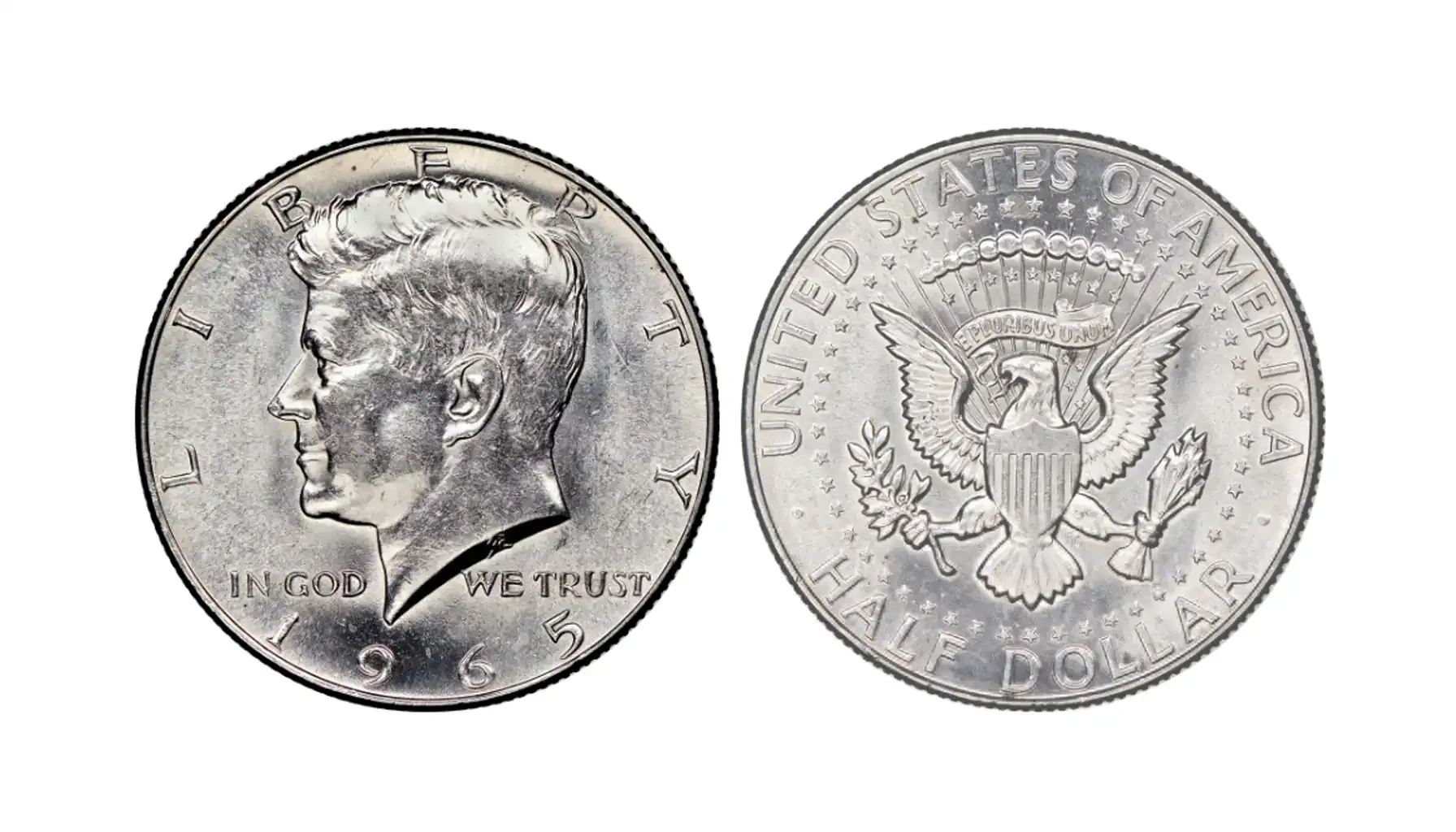
How Much Is a 1965 Half Dollar Worth Today?
The current market for 1965 half dollar value today varies dramatically based on condition and origin. According to the NGC Price Guide, circulated examples typically trade between $4.90 and $5.50, reflecting their silver content premium over face value. However, the open market reveals much higher potential values for exceptional specimens.
Condition | Approx. Value (USD) |
Good (heavily worn) | ~$5 (mostly silver value) |
Fine (moderate wear) | ~$5 |
Very Fine (light wear) | ~$5 |
Extra Fine (minimal wear) | ~$6 |
About Uncirculated (AU) | ~$6–8 |
Uncirculated (MS-60) | ~$9 |
Choice Uncirculated (MS-63) | ~$12 |
Gem Uncirculated (MS-65) | ~$50+ |
Superb Gem (MS-67) | $2,000+ (conditional rarity) |
The dramatic value increase for higher grades reflects the scarcity in mint state condition, which is a key factor in answering what is a 1965 half dollar worth. Fewer than 20 pieces have been graded MS67 by major grading services, with none certified at higher grades. This rarity in top condition makes exceptional examples highly sought after by collectors—see Silver US Half Dollar Value for an in-depth look at low survival rates and high-grade scarcity among Walking 1965 Liberty half dollar.
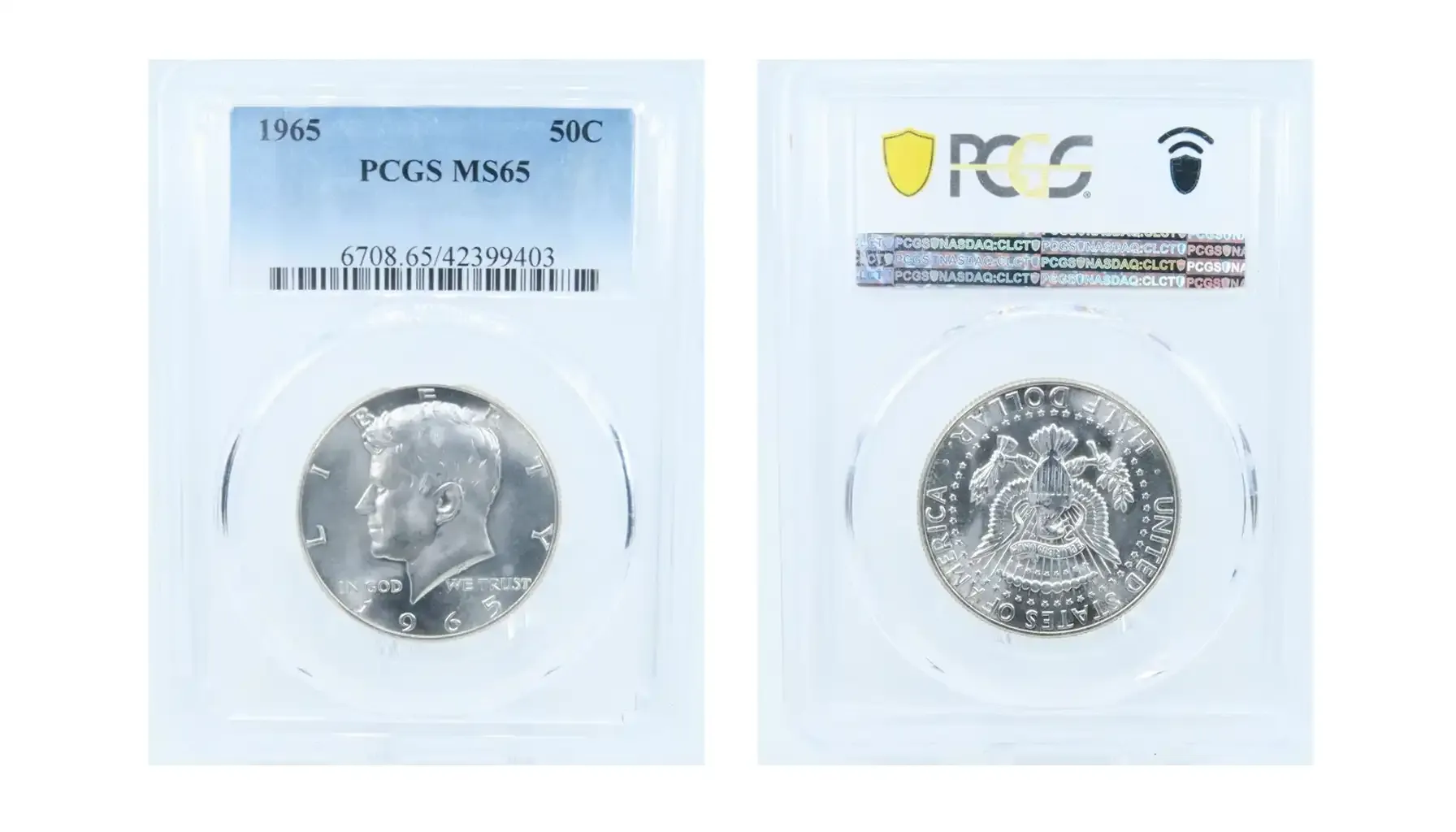
What Makes a 1965 Kennedy Half Dollar Rare?
Several factors contribute to the rarity and value of 1965 Kennedy half dollars beyond their basic silver content. The coin's position in numismatic history as the first year of reduced silver content makes it significant to collectors studying the transition period in American coinage.
Key rarity factors include:
High-grade preservation - Most of the entered circulation, making mint state examples scarce
Special Mint Set origin - SMS coins exhibit superior striking quality and reflective surfaces
Error varieties - Planchet errors, die varieties, and striking anomalies create unique specimens
Historical significance - Second year of Kennedy series during a transitional period in coinage
The Special Mint Set program, implemented due to suspension of regular proof production, created approximately 2,360,000 sets containing higher-quality pieces. These coins display enhanced striking characteristics and semi-reflective surfaces that distinguish them from regular circulation strikes.
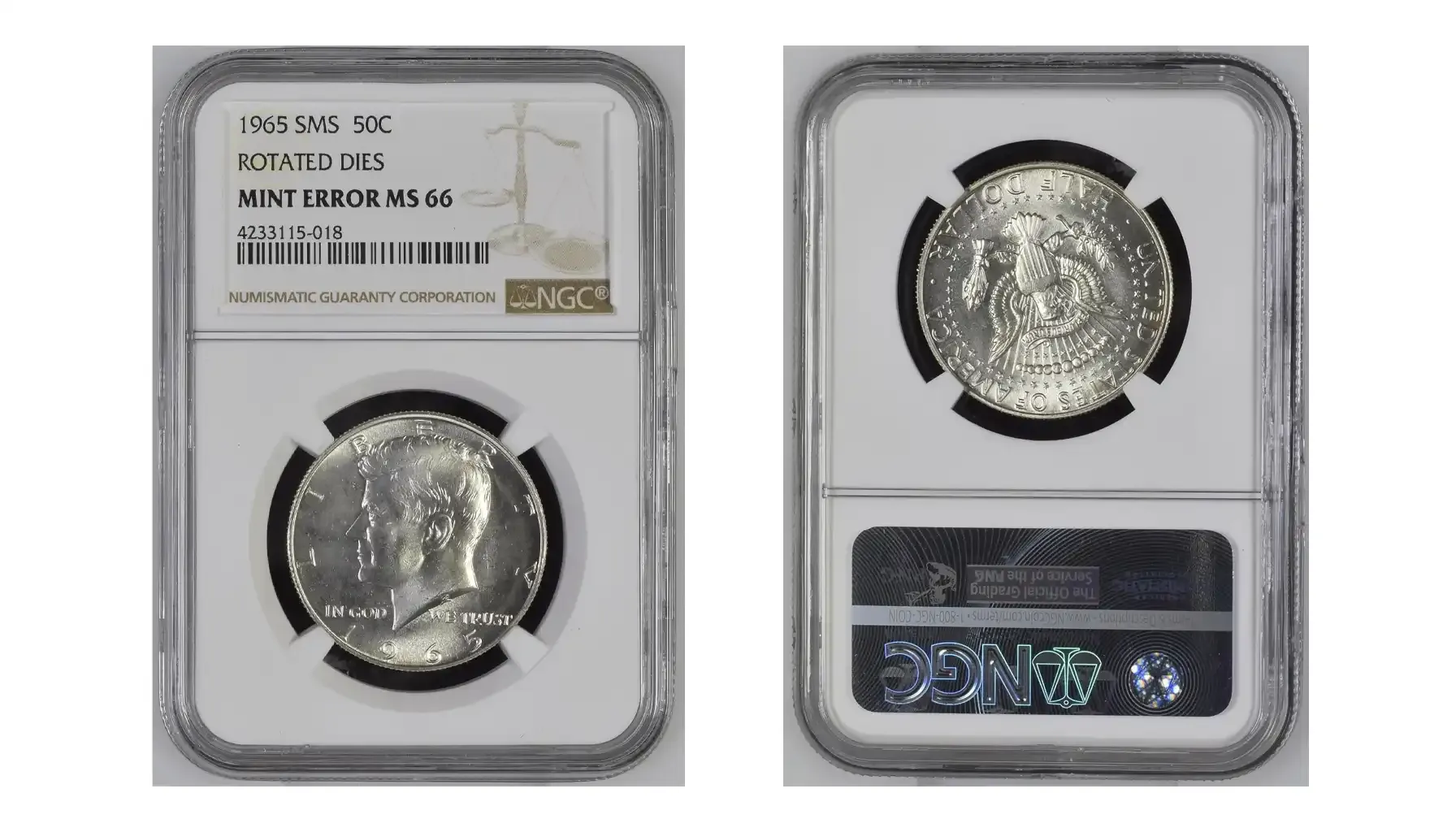
The Switch to 40% Silver – Why It Matters
The composition change from 90% to 40% silver in 1965 represented a crucial economic decision by the U.S. Treasury. Rising silver prices and increasing demand for coins created shortages that threatened normal commerce. The innovative clad composition allowed continued 1965 silver half dollar value content while reducing costs and hoarding incentives.
Each specimen contains 0.1479 troy ounces of pure silver, providing intrinsic value beyond face value even for worn specimens. The coin weighs 11.50 grams compared to the 12.50-gram weight of 1964's 90% silver version. This weight difference serves as one method for distinguishing between the two compositions.
The economic impact extended beyond individual coins. The reduced silver content helped stabilize coin production while maintaining public acceptance of the Kennedy design. This compromise solution preceded the complete elimination of silver from those beginning in 1971, when composition changed to copper-nickel clad—see Who Was on the Half Dollar for a detailed overview of these compositional changes.
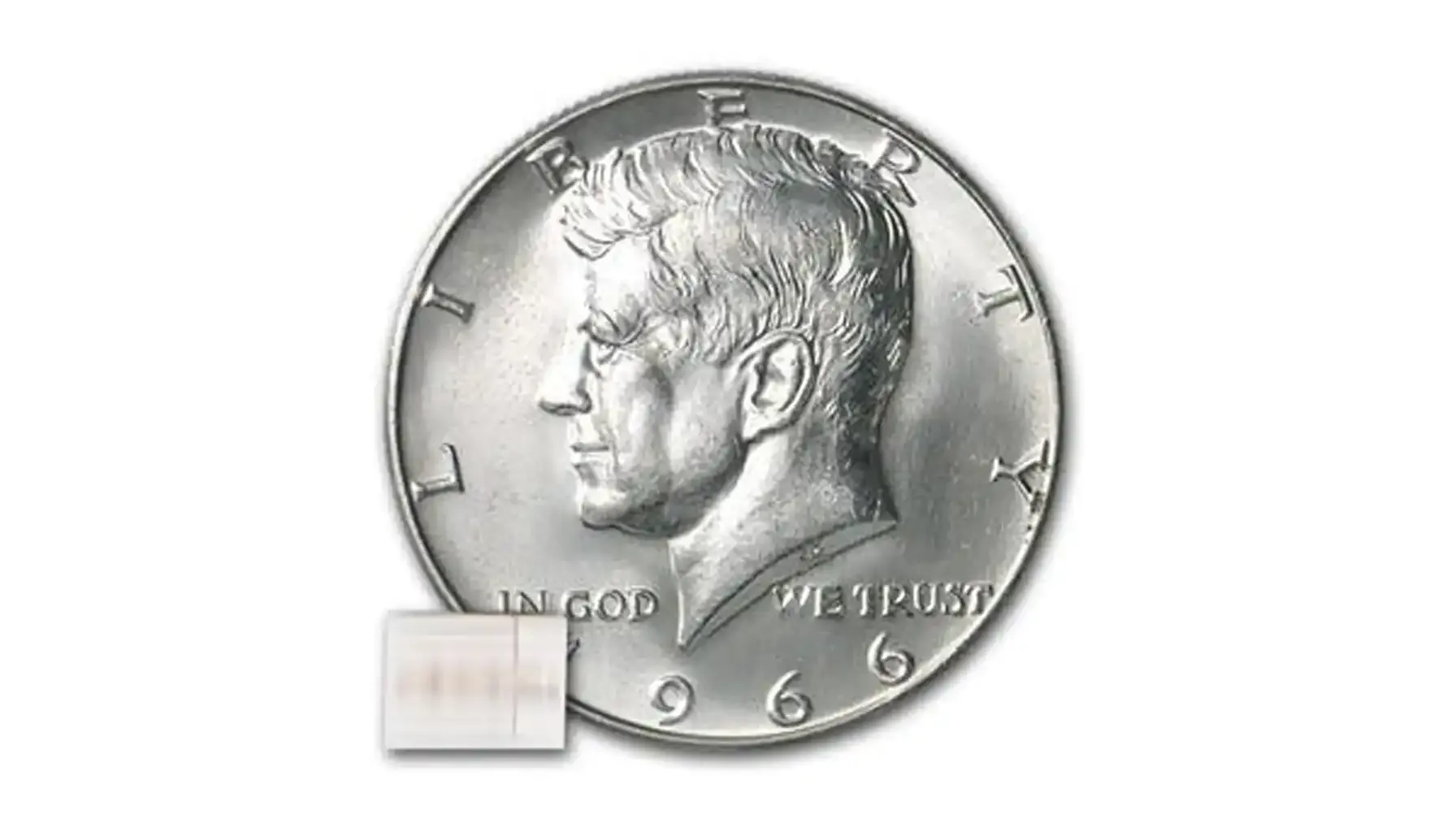
Understanding SMS Coins and Their Higher Value
Special Mint Sets represented the U.S. Mint's response to suspended proof production in 1965. The 1965 SMS Kennedy half dollar was struck at the San Francisco Assay Office using enhanced production techniques, resulting in coins with superior eye appeal compared to regular circulation strikes. When considering how much is a 1965 Kennedy half dollar worth, it’s important to note that SMS coins typically command higher premiums than business strikes.
SMS coins versus business strikes exhibit several distinguishing characteristics:
Enhanced striking pressure - Creates sharper details and better definition
Semi-reflective surfaces - More lustrous than circulation strikes but less mirrored than proofs
Superior planchet preparation - Cleaner, more attractive surfaces
Quality control - Higher standards for surface marks and imperfections
Packaging - Originally sold in soft packaging, later upgraded to hard cases
Collectors particularly value SMS coins that exhibit cameo or deep cameo contrast, where frosted devices stand out against reflective fields. These premium examples can command significant multiples over regular SMS coins, further increasing the value of 1965 Kennedy half dollar pieces in top condition.
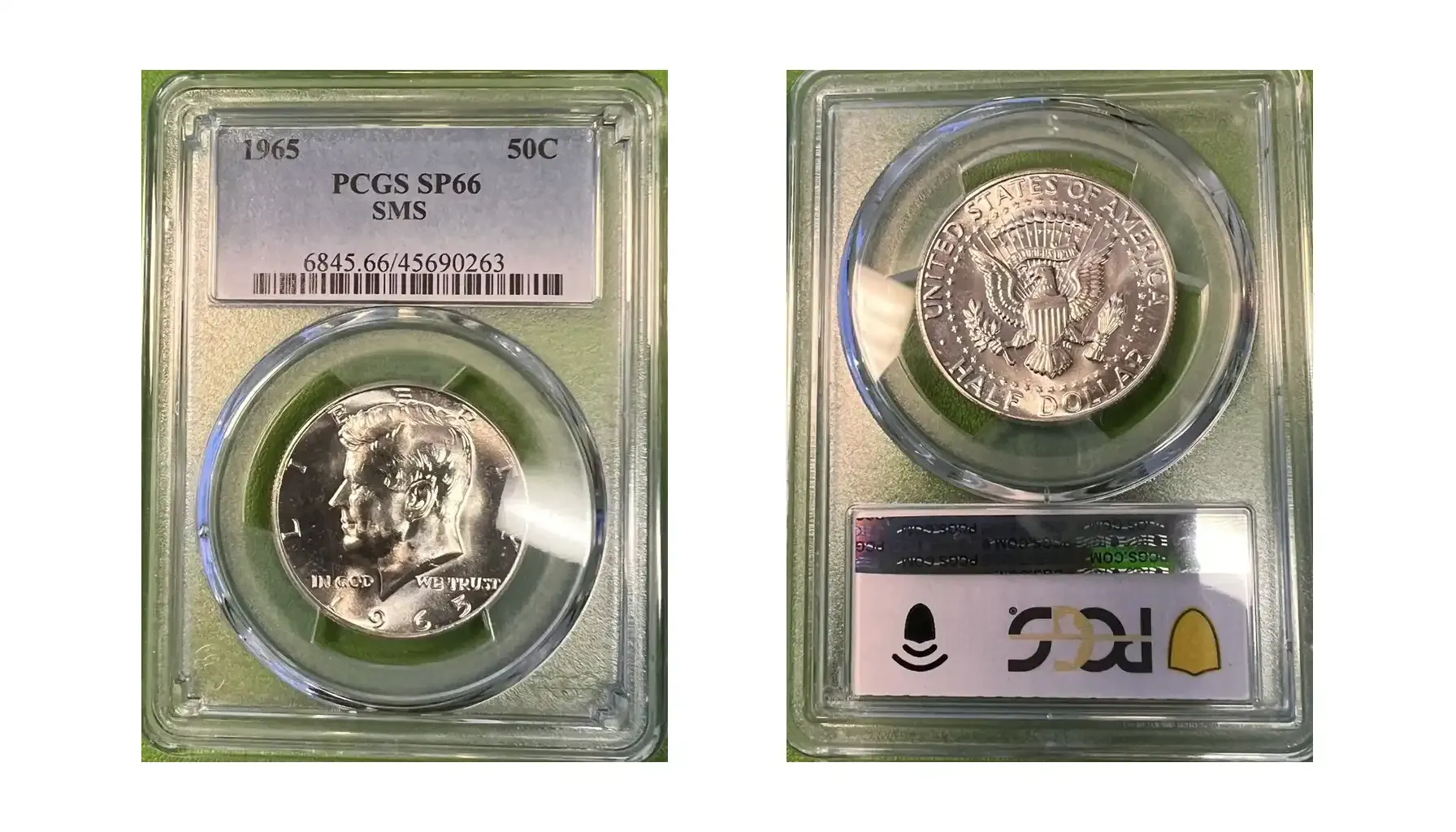
Common Varieties: 1965 Kennedy Half Dollar Error
Like many U.S. coins, this one has its share of varieties and mint errors that intrigue collectors. While the series doesn’t have a long list of varieties in that year, a couple of notable issues can significantly impact value.
Doubled Die Reverse (DDR)
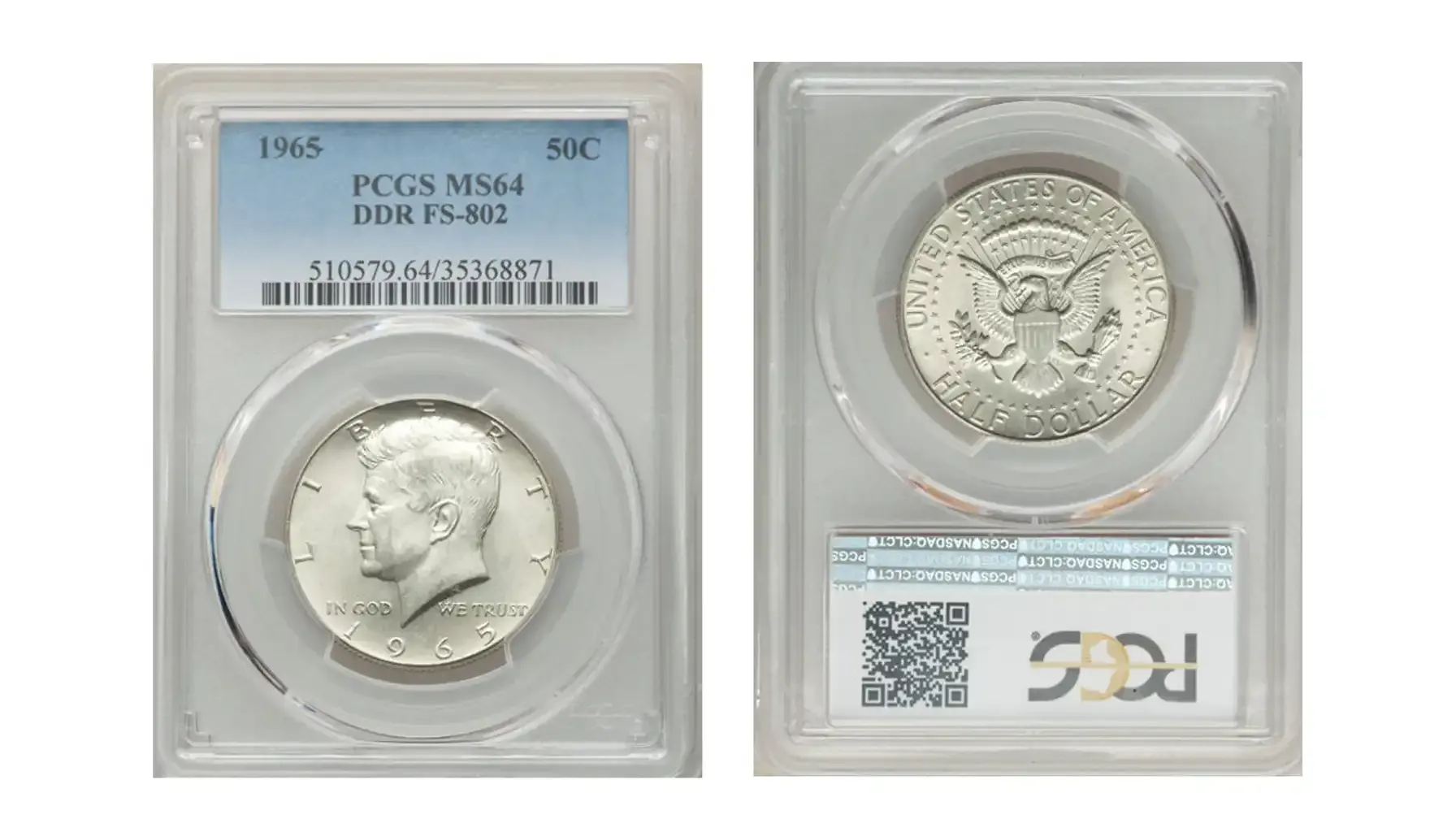
This is the most famous variety for 1965 halves. A doubled die occurs when a coin die has misaligned impressions from the hub, resulting in doubled images on coins struck by that die. In 1965, some (both regular and SMS strikes) were made with a doubled reverse die. Collectors can spot a DDR by looking for doubling on the lettering (for example, the letters in “Half Dollar” or “United States of America” may show a shadowed doubling).
The 1965 DDR is cataloged in specialty guides (e.g., as FS-801/802 in the CherryPickers’ Guide). These error-variety coins carry a premium: even lower uncirculated grades can be worth dozens of dollars. In mint state MS63, a DDR might fetch around $90, and in MS65 it could reach a few hundred dollars.
The finest known DDR examples (MS66 or so) have surpassed the thousand-dollar mark at auctions. By contrast, a normal 1965 in MS65 might be only $50, which shows the impact of this variety on value. If you suspect your 1965 half has doubling, consider getting it attributed by an expert or grading service – it could be a rewarding find.
Struck on a Clad Quarter Planchet

This is a dramatic mint error rather than an intentional variety. In 1965, quarters were made of the new copper-nickel clad composition (with no silver), while half dollars were larger and 40% silver.
Occasionally, a design was mistakenly struck on a planchet meant for a quarter. The result is a smaller, underweight coin with the Kennedy half design—but parts of the design cut off (for instance, the word “LIBERTY” might be partially missing at the rim due to the smaller blank).
These error coins are immediately noticeable: they have a silver-colored appearance but a quarter’s size (and a weight of about 5.7g, much less than the normal 11.5g half). Such errors are extremely scarce. One verified example of a 1965 half on a quarter planchet sold for roughly $975 at auction.
If you ever find one that seems too small or light, you might have an extraordinary mint mistake on your hands.
Other Errors

Apart from the two above, standard mint mishaps like off-center strikes, clipped planchets, or die cracks can be found on 1965 halves. These are not unique to 1965, but they do add collector interest. Most have modest value unless very prominent. For example, an off-center 1965 (with a chunk of design missing) could be worth $20–$50 or more depending on severity. A note of caution: No mint mark on 1965 is normal, not an error – all 1965–1967 coins intentionally lack mint marks by law, so don’t mistake the missing “P” or “D” as a special variety.
Two error types in particular – the Doubled Die Reverse and the wrong planchet error – are the headline-grabbers for 1965 Kennedy halves. They’re relatively rare but well-known among collectors, and they can turn an otherwise common 1965 JFK half dollar into a substantially more valuable piece. Checking your 1965 halves for these anomalies (especially doubling) is certainly worth the effort.
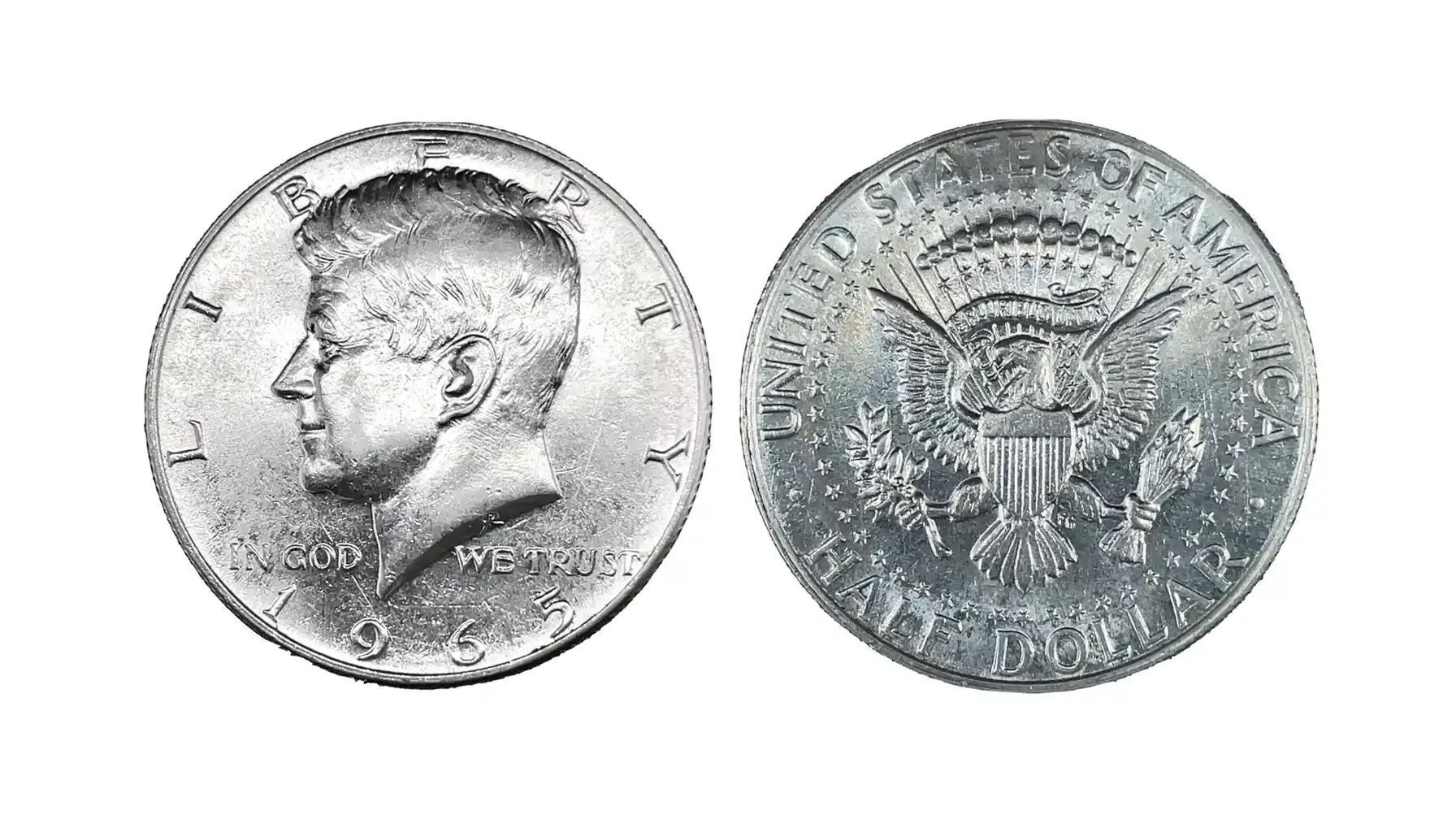
How to Tell if Your 1965 Half Dollar Is Silver
Distinguishing 1965 half dollar silver from later clad versions requires understanding the physical properties that differentiate compositions. Since all the specimens contain 40% silver, collectors often ask how much silver is in a 1965 Kennedy half dollar or how to tell them apart from later clad coins. Here are three reliable home testing methods:
Weight verification: Authentic 1965 halves weigh 11.50 grams, which helps confirm how much silver in a 1965 Kennedy half dollar.
Sound test: Silver coins produce a distinctive ring, a quick way to check for silver content and estimate 1965 silver half dollar value.
Edge examination: The 40% silver clad shows a different edge coloration than copper-nickel coins, useful for spotting silver content.
A magnet test can also help, but results may vary due to the coin’s mixed metals.
As for Franklin halves, there are no 1965 Franklin half dollars—the series ended in 1963, and only Kennedy designs were minted from 1964 onward.
Are There Any 1965 Franklin Half Dollars?
A common misconception is the existence of a 1965 Benjamin Franklin half dollar. The Franklin half dollar series concluded in 1963, with the final coins struck that year. No Franklin ones bear a 1965 date, as the Kennedy design was adopted for the entire production beginning in 1964.
Design Type | Years Produced | Final Year |
Franklin HD | 1948-1963 | 1963 |
Kennedy HD | 1964-Present | Ongoing |
This confusion often arises from Franklin halves found in circulation during 1965, leading some to believe they were produced that year. However, all 1965 half dollars feature Kennedy's portrait and the heraldic eagle reverse design—there is no such thing as a 1965 ben franklin half dollar value.
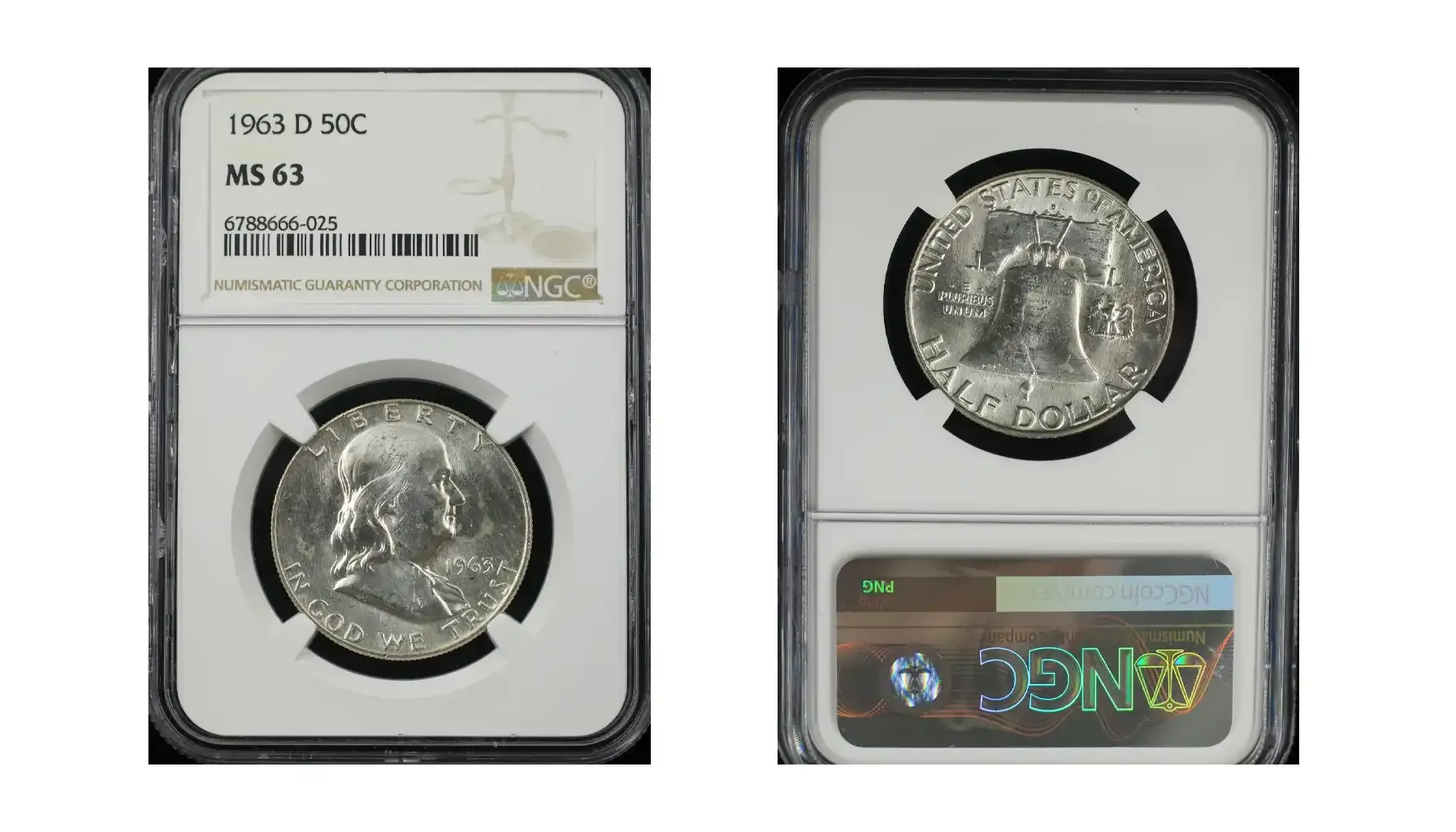
Where and How to Sell Your Pieces
Selling requires understanding current market conditions and choosing appropriate venues based on coin quality and value. If you’re looking to determine half dollar 1965 value, common circulated examples can be sold to local coin dealers or online platforms, while higher-grade specimens may warrant auction consignment.
For average circulated coins worth $5-10, local coin shops provide convenient transactions with immediate payment. Online platforms like eBay allow broader market reach but involve fees and shipping considerations. Keep in mind, pre 1965 half dollar value is typically higher due to 90% silver content, but 1965 halves still carry solid premiums for their 40% silver.
Professional grading through NGC or PCGS adds credibility and often increases values for exceptional specimens. However, grading costs should be weighed against potential value increases, making it most beneficial for coins likely to grade MS65 or higher.
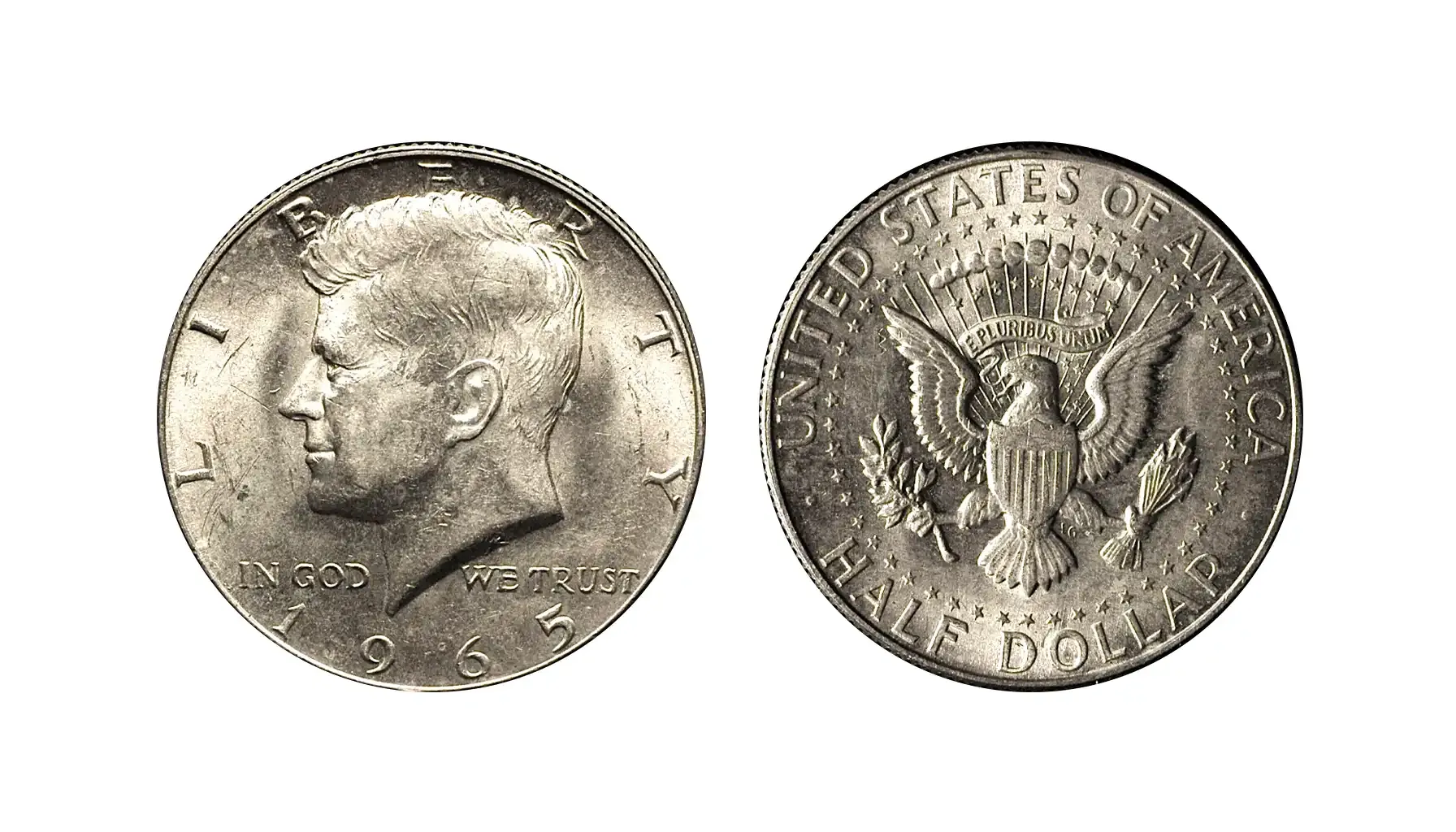
Hold or Flip: What’s the Best Move for Your Coin?
The decision to hold or sell 1965 Kennedy half dollars depends on individual circumstances, coin quality, and market outlook. If you’re wondering what is the value of a 1965 Kennedy half dollar, remember that silver content provides a floor value that fluctuates with precious metals markets, while numismatic premiums for exceptional specimens continue growing with collector demand
Reasons to hold include long-term silver value appreciation, potential numismatic premium growth, and historical significance as transitional coinage. Conversely, selling makes sense for immediate financial needs, portfolio diversification, or when coins lack exceptional quality that would drive future premiums.
The coins of the united series, especially the Kennedy half dollar 1965 issue, enjoy sustained collector interest—particularly for coins representing significant design or composition changes like the 1965 half dollar. This continued demand suggests stable or growing values for quality examples, making them reasonable long-term holdings for patient collectors.

